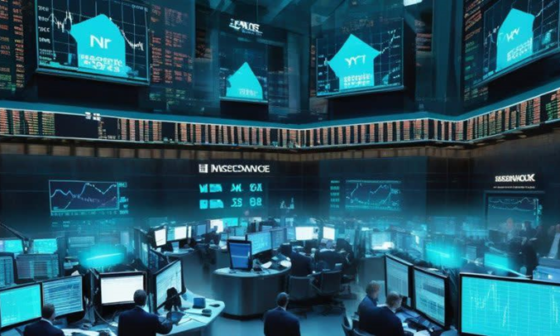Are you trading in the markets like Forex or Crypto but still struggling for consistent returns? You need to have a strong understanding of the risk-return ratio to improve your market performance. Sharpe Ratio is a tool that evaluates an investment’s return and its associated volatility, with its formula derived by Nobel Prize Winner William Sharpe. Whether you’re trying to gauge how much risk comes along with any trade you take or if something is too risky of an investment, this blog post on Sharpe Ratio will provide an introductory understanding into why it’s so important and how to use it while making trades!
What Sharpe Ratio is and What it Measures
A Sharpe ratio is a statistical measure that analysts use to evaluate the performance of investments. It is calculated as the difference between the return on an investment portfolio and the return of a risk-free asset, divided by the standard deviation of returns (also known as volatility). The higher a Sharpe ratio score, the better the performance of an investment relative to its risk. Similarly,average drawdown measures how much wealth has been lost below a historical maximum value when trading with a strategy. It provides insight into historical losses incurred due to bad trades over different points in time. Therefore, investors looking for strategies with low maximum drawdowns are most likely seeking strategies with very low risk but lower long term returns.
How to Calculate Sharpe Ratio
Calculating the Sharpe ratio is a great way to measure the performance of an investment portfolio. The formula includes calculating the expected return of an investment minus any risk-free rate of return, divided by its standard deviation. Knowing how to calculate a Sharpe ratio can be invaluable information when it comes to measuring how profitable your investments are compared to the risks they trigger, so understanding this formula is strongly recommended if you’re looking for greater success in the markets.
Uses and Benefits of Sharpe Ratio
The Sharpe Ratio is a helpful tool when it comes to gauging investment performance as it measures the excess return per unit of risk taken. Whereas other metrics only measure returns, the Sharpe Ratio considers both the expected returns and the amount of volatility or risk taken to reach those returns. By using the Sharpe Ratio, investors can avoid taking too much risk in pursuit of their desired results, while still pursuing maximum potential gains. The ratio provides a sensible metric for measuring whether investments are within an acceptable range of risk versus reward, providing traders and investors with a valuable method for evaluating their portfolios’ performance.
Limitations of Sharpe Ratio
The Sharpe Ratio is a statistic that helps to measure the effectiveness of an investment by taking into account its risk and return. However, there are several limitations that potential investors should take into consideration before they rely heavily on this metric. These include the assumptions that high and low volatility investments are equal as well as the calculations being done over a sustained period of time in order to accurately assess the investment. Furthermore, computing the Sharpe Ratio requires an estimate of the “risk-free rate” which can change over time depending on market conditions. This can lead to inaccurate results if not taken into account. Ultimately, while useful in some cases, The Sharpe Ratio should not be used alone for investor decision-making and other factors should be taken into consideration as well.
Comparison of Different Types of Ratios
The Sharpe ratio is a particularly useful type of ratio that investors use to measure the effectiveness of their investments. It compares the return generated on an investment relative to its riskiness, taking into account the investor’s risk-free rate. A high Sharpe ratio (compared to other investments) means that there should be a higher return with lower volatility. Other types of ratios used by investors include the price-to-earnings ratio, dividend yield, and payout ratio. Comparing these ratios can be used to evaluate whether it is worth investing in particular stocks. Knowing how to compare different ratios can provide important information for understanding and confidently making decisions about your investments’ performance.
Examples of how to Use Sharpe Ratio in Investing
The Sharpe ratio is a useful metric for investors to gauge the trade-off between risk and return; in general, a higher Sharpe ratio implies higher risk-adjusted returns. When evaluating investment options, investors can compare the Sharpe ratio across different funds or portfolios to get an idea of how much return they can expect for each unit of volatility they’re taking on. Importantly, the Sharpe ratio should be calculated using historical performance data, such as past stock or bond prices. The number won’t be able to tell what will happen in the future, but it’s still a valuable statistic for comparing investments and judging their potential risk/reward balance.
Conclusion
The Sharpe ratio is a very popular tool that measures risk-adjusted return. It does this by dividing the excess return over the risk-free rate by the standard deviation of returns. The Sharpe ratio is useful because it allows investors to compare apples to apples when comparing different investments. For example, if one investment has a higher return but also higher volatility, the Sharpe ratio will tell you which investment is better adjusted for risk. Although the Sharpe ratio is a very powerful tool, it does have some limitations that you should be aware of before using it in your investment decisions. These include its use of historical data and its lack of consideration for specific types of risks. Despite these limitations, the Sharpe ratio remains one of the most popularrisk-adjusted return measures and can be helpful in making investment decisions. If you’re interested in learning more about how successful traders use ratios like the Sharpe Ratio in their investing, subscribe to our free trading strategies newsletter below.





